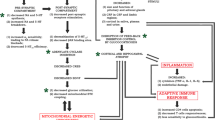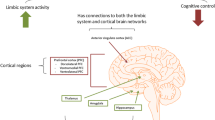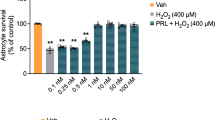Abstract
Antidepressant medication is the standard treatment for major depression disorder (MDD). However, the response to these treatments is often incomplete and many patients remain refractory. In the present study, we show that the glucocorticoid receptor (GR) agonist dexamethasone (DEX) increased MAPK/ERK1/2 signaling in the presence of the noradrenergic antidepressant, desipramine (DMI), while no such effect was induced by DEX or DMI alone in human neuroblastoma SH-SY5Y cells. This enhancement was dependent on the activation of both α2 adrenergic receptors (AR) and GR. The timing of MAPK/ERK1/2 activation as well as DEX-induced reduction in membranous α2 AR suggests the involvement of a β-arrestin-dependent mechanism. In line with the latter, DEX increased cytosolic and decreased membranous levels of β-arrestin. Concomitantly, DEX induced a time-dependent increase in cytosolic α2 AR-β-arrestin interaction and a decrease in β-arrestin interaction with Mdm2 E3 ubiquitin ligase. All of these effects of DEX were prevented by the GR antagonist RU486. Our data suggest an additional intracellular role for DEX, in which activation of GR interferes with the trafficking and degradation of β-arrestin-α2c-AR complex. We suggest that such an interaction in the presence of DMI can enhance MAPK/ERK1/2 signaling, a key player in neural plasticity and neurogenesis processes, which is impaired in MDD, while stimulated by antidepressants.





Similar content being viewed by others

References
Adler CH, Meller E, Goldstein M (1987) Receptor reserve at the alpha-2 adrenergic receptor in the rat cerebral cortex. J Pharmacol Exp Ther 240:508–515
Ahn S, Wei H, Garrison TR, Lefkowitz RJ (2004) Reciprocal regulation of angiotensin receptor-activated extracellular signal-regulated kinases by beta-arrestins 1 and 2. J Biol Chem 279:7807–7811
Alblas J, van Corven EJ, Hordijk PL, Milligan G, Moolenaar WH (1993) Gi-mediated activation of the p21ras-mitogen-activated protein kinase pathway by alpha 2-adrenergic receptors expressed in fibroblasts. J Biol Chem 268:22235–22238
Avissar S, Matuzany-Ruban A, Tzukert K, Schreiber G (2004) Beta-arrestin-1 levels: reduced in leukocytes of patients with depression and elevated by antidepressants in rat brain. Am J Psychiatry 161:2066–2072
Bayer M, Kuci Z, Schomig E, Grundemann D, Dittmann H, Handgretinger R, Bruchelt G (2009) Uptake of mIBG and catecholamines in noradrenaline- and organic cation transporter-expressing cells: potential use of corticosterone for a preferred uptake in neuroblastoma- and pheochromocytoma cells. Nucl Med Biol 36:287–294
Ben-Shachar D, Karry R (2007) Sp1 expression is disrupted in schizophrenia; a possible mechanism for the abnormal expression of mitochondrial complex I genes, NDUFV1 and NDUFV2. PLoS ONE 2:e817
Biedler JL, Roffler-Tarlov S, Schachner M, Freedman LS (1978) Multiple neurotransmitter synthesis by human neuroblastoma cell lines and clones. Cancer Res 38:3751–3757
Bouwer C, Claassen J, Dinan TG, Nemeroff CB (2000) Prednisone augmentation in treatment-resistant depression with fatigue and hypocortisolaemia: a case series. Depress Anxiety 12:44–50
Chen G, Manji HK (2006) The extracellular signal-regulated kinase pathway: an emerging promising target for mood stabilizers. Curr Opin Psychiatry 19:313–323
Cottingham C, Chen Y, Jiao K, Wang Q (2011) The antidepressant desipramine is an arrestin-biased ligand at the alpha(2A)-adrenergic receptor driving receptor down-regulation in vitro and in vivo. J Biol Chem 286:36063–36075
Davies L, Paraskevopoulou E, Sadeq M, Symeou C, Pantelidou C, Demonacos C, Krstic-Demonacos M (2011) Regulation of glucocorticoid receptor activity by a stress responsive transcriptional cofactor. Mol Endocrinol 25:58–71
DeBattista C, Posener JA, Kalehzan BM, Schatzberg AF (2000) Acute antidepressant effects of intravenous hydrocortisone and CRH in depressed patients: a double-blind, placebo-controlled study. Am J Psychiatry 157:1334–1337
DeGraff JL, Gagnon AW, Benovic JL, Orsini MJ (1999) Role of arrestins in endocytosis and signaling of alpha2-adrenergic receptor subtypes. J Biol Chem 274:11253–11259
DeWire SM, Ahn S, Lefkowitz RJ, Shenoy SK (2007) Beta-arrestins and cell signaling. Annu Rev Physiol 69:483–510
Dinan TG, Lavelle E, Cooney J, Burnett F, Scott L, Dash A, Thakore J, Berti C (1997) Dexamethasone augmentation in treatment-resistant depression. Acta Psychiatr Scand 95:58–61
Donnici L, Tiraboschi E, Tardito D, Musazzi L, Racagni G, Popoli M (2008) Time-dependent biphasic modulation of human BDNF by antidepressants in neuroblastoma cells. BMC Neurosci 9:61–66
Duman CH, Schlesinger L, Kodama M, Russell DS, Duman RS (2007) A role for MAP kinase signaling in behavioral models of depression and antidepressant treatment. Biol Psychiatry 61:661–670
Dwivedi Y, Rizavi HS, Roberts RC, Conley RC, Tamminga CA, Pandey GN (2001) Reduced activation and expression of ERK1/2 MAP kinase in the post-mortem brain of depressed suicide patients. J Neurochem 77:916–928
Eickelberg O, Roth M, Lorx R, Bruce V, Rudiger J, Johnson M, Block LH (1999) Ligand-independent activation of the glucocorticoid receptor by beta2-adrenergic receptor agonists in primary human lung fibroblasts and vascular smooth muscle cells. J Biol Chem 274:1005–1010
Fraser CC (2008) G protein-coupled receptor connectivity to NF-kappaB in inflammation and cancer. Int Rev Immunol 27:320–350
Golan M, Schreiber G, Avissar S (2011) Antidepressants elevate GDNF expression and release from C glioma cells in a beta-arrestin1-dependent, CREB interactive pathway. Int J Neuropsychopharmacol 14:1289–1300
Golan M, Schreiber G, Avissar S (2013) Antidepressant-induced differential ubiquitination of beta-arrestins 1 and 2 in mononuclear leucocytes of patients with depression. Int J Neuropsychopharmacol 16:1745–1754
Haske T, Nakao M, Moudgil VK (1994) Phosphorylation of immunopurified rat liver glucocorticoid receptor by the catalytic subunit of cAMP-dependent protein kinase. Mol Cell Biochem 132:163–171
Laifenfeld D, Klein E, Ben-Shachar D (2002) Norepinephrine alters the expression of genes involved in neuronal sprouting and differentiation: relevance for major depression and antidepressant mechanisms. J Neurochem 83:1054–1064
Laifenfeld D, Karry R, Grauer E, Klein E, Ben-Shachar D (2005) Antidepressants and prolonged stress in rats modulate CAM-L1, laminin, and pCREB, implicated in neuronal plasticity. Neurobiol Dis 20:432–441
Liu J, Haigh RM, Jones CT (1992) Enhancement of noradrenaline-induced inositol polyphosphate formation by glucocorticoids in rat vascular smooth muscle cells. J Endocrinol 133:405–411
Manji HK, Drevets WC, Charney DS (2001) The cellular neurobiology of depression. Nat Med 7:541–547
Moore CA, Milano SK, Benovic JL (2007) Regulation of receptor trafficking by GRKs and arrestins. Annu Rev Physiol 69:451–482
Morishita R, Nagata K, Ito H, Ueda H, Asano M, Shinohara H, Kato K, Asano T (2007) Expression of smooth muscle cell-specific proteins in neural progenitor cells induced by agonists of G protein-coupled receptors and transforming growth factor-beta. J Neurochem 101:1031–1040
Nestler EJ, Barrot M, DiLeone RJ, Eisch AJ, Gold SJ, Monteggia LM (2002) Neurobiology of depression. Neuron 34:13–25
Nibuya M, Nestler EJ, Duman RS (1996) Chronic antidepressant treatment increases the expression of cAMP response element binding protein (CREB) in rat hippocampus. J Neurosci 16:2365–2372
Pariante CM, Miller AH (2001) Glucocorticoid receptors in major depression: relevance to pathophysiology and treatment. Biol Psychiatry 49:391–404
Pariante CM, Thomas SA, Lovestone S, Makoff A, Kerwin RW (2004) Do antidepressants regulate how cortisol affects the brain? Psychoneuroendocrinology 29:423–447
Parsley S, Gazi L, Bobirnac I, Loetscher E, Schoeffter P (1999) Functional alpha2C-adrenoceptors in human neuroblastoma SH-SY5Y cells. Eur J Pharmacol 372:109–115
Philipp M, Brede M, Hein L (2002) Physiological significance of α2-adrenergic receptor subtype diversity: one receptor is not enough. Am J Physiol—Regul, Integr Comp Physiol 283:R287–R295
Pinkas J, Naber SP, Butel JS, Medina D, Jerry DJ (1999) Expression of MDM2 during mammary tumorigenesis. Int J Cancer 81:292–298
Pittenger C, Duman RS (2008) Stress, depression, and neuroplasticity: a convergence of mechanisms. Neuropsychopharmacology 33:88–109
Sahay A, Hen R (2007) Adult hippocampal neurogenesis in depression. Nat Neurosci 10:1110–1115
Schmidt M, Michel MC (2011) How can 1 + 1 = 3? beta2-adrenergic and glucocorticoid receptor agonist synergism in obstructive airway diseases. Mol Pharmacol 80:955–958
Sengupta S, Wasylyk B (2001) Ligand-dependent interaction of the glucocorticoid receptor with p53 enhances their degradation by Hdm2. Genes Dev 15:2367–2380
Serretti A, Calati R, Goracci A, Di Simplicio M, Castrogiovanni P, De Ronchi D (2010) Antidepressants in healthy subjects: what are the psychotropic/psychological effects? Eur Neuropsychopharmacol 20:433–453
Shenoy SK, Lefkowitz RJ (2005) Receptor-specific ubiquitination of beta-arrestin directs assembly and targeting of seven-transmembrane receptor signalosomes. J Biol Chem 280:15315–15324
Shenoy SK, McDonald PH, Kohout TA, Lefkowitz RJ (2001) Regulation of receptor fate by ubiquitination of activated beta 2-adrenergic receptor and beta-arrestin. Science 294:1307–1313
Shenoy SK, Drake MT, Nelson CD, Houtz DA, Xiao K, Madabushi S, Reiter E, Premont RT, Lichtarge O, Lefkowitz RJ (2006) Beta-arrestin-dependent, G protein-independent ERK1/2 activation by the beta2 adrenergic receptor. J Biol Chem 281:1261–1273
Shenoy SK, Modi AS, Shukla AK, Xiao K, Berthouze M, Ahn S, Wilkinson KD, Miller WE, Lefkowitz RJ (2009) Beta-arrestin-dependent signaling and trafficking of 7-transmembrane receptors is reciprocally regulated by the deubiquitinase USP33 and the E3 ligase Mdm2. Proc Natl Acad Sci USA 106:6650–6655
Sun Z, Fan Y, Zha Q, Zhu MY (2010) Corticosterone up-regulates expression and function of norepinephrine transporter in SK-N-BE(2)C cells. J Neurochem 113:105–116
Ueda K, Okamura N, Hirai M, Tanigawara Y, Saeki T, Kioka N, Komano T, Hori R (1992) Human P-glycoprotein transports cortisol, aldosterone, and dexamethasone, but not progesterone. J Biol Chem 267:24248–24252
Wallace AD, Cidlowski JA (2001) Proteasome-mediated glucocorticoid receptor degradation restricts transcriptional signaling by glucocorticoids. J Biol Chem 276:42714–42721
Wang P, Gao H, Ni Y, Wang B, Wu Y, Ji L, Qin L, Ma L, Pei G (2003) Beta-arrestin 2 functions as a G-protein-coupled receptor-activated regulator of oncoprotein Mdm2. J Biol Chem 278:6363–6370
Wang L, Peng D, Xie B, Jiang K, Fang Y (2012) The extracellular signal-regulated kinase pathway may play an important role in mediating antidepressant-stimulated hippocampus neurogenesis in depression. Med Hypotheses 79:87–91
Yaniv SP, Ben-Shachar D, Klein E (2008) Norepinephrine-glucocorticoids interaction does not annul the opposite effects of the individual treatments on cellular plasticity in neuroblastoma cells. Eur J Pharmacol 596:14–24
Yaniv SP, Lucki A, Klein E, Ben-Shachar D (2010) Dexamethasone enhances the norepinephrine-induced ERK/MAPK intracellular pathway possibly via dysregulation of the alpha2-adrenergic receptor: implications for antidepressant drug mechanism of action. Eur J Cell Biol 89:712–722
Yuan P, Zhou R, Wang Y, Li X, Li J, Chen G, Guitart X, Manji HK (2010) Altered levels of extracellular signal-regulated kinase signaling proteins in postmortem frontal cortex of individuals with mood disorders and schizophrenia. J Affect Disord 124:164–169
Acknowledgments
This study was supported by a grant of the Chief Scientist of the Israeli Ministry of Health. Mdm2 antibodies were obtained as a gift from Prof. A. Ciechanover, Technion IIT, Israel.
Conflict of interest
None.
Author information
Authors and Affiliations
Corresponding author
Rights and permissions
About this article
Cite this article
Lucki, A., Klein, E., Karry, R. et al. Dexamethasone in the presence of desipramine enhances MAPK/ERK1/2 signaling possibly via its interference with β-arrestin. J Neural Transm 121, 289–298 (2014). https://doi.org/10.1007/s00702-013-1099-5
Received:
Accepted:
Published:
Issue Date:
DOI: https://doi.org/10.1007/s00702-013-1099-5



